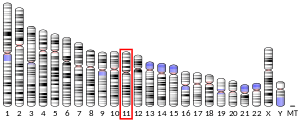SLC22A12
Solute carrier family 22 (organic anion/cation transporter), member 12, also known as SLC22A12 and URAT1, is a protein which in humans is encoded by the SLC22A12 gene.[4][5]
Function
The protein encoded by this gene is a urate transporter and urate-anion exchanger which regulates the level of urate in the blood. This protein is an integral membrane protein primarily found in kidney. Two transcript variants encoding different isoforms have been found for this gene.[4]
Clinical significance
Numerous single nucleotide polymorphisms of this gene are significantly associated with altered (increased or decreased) reabsorption of uric acid by the kidneys.[6][7] Respectively, these altered rates of reabsorption contribute to hyperuricemia and hypouricemia.
Inhibition
Lesinurad is a urate transporter inhibitor that has been approved to treat gout.[9] Lesinurad enhances urate excretion by inhibition the tubular re-absorption. Probenecid also facilitates uric acid secretion.[10][11]
See also
References
- GRCh38: Ensembl release 89: ENSG00000197891 - Ensembl, May 2017
- "Human PubMed Reference:". National Center for Biotechnology Information, U.S. National Library of Medicine.
- "Mouse PubMed Reference:". National Center for Biotechnology Information, U.S. National Library of Medicine.
- "Entrez Gene: SLC22A12 solute carrier family 22 (organic anion/cation transporter), member 12".
- Enomoto A, Kimura H, Chairoungdua A, Shigeta Y, Jutabha P, Cha SH, Hosoyamada M, Takeda M, Sekine T, Igarashi T, Matsuo H, Kikuchi Y, Oda T, Ichida K, Hosoya T, Shimokata K, Niwa T, Kanai Y, Endou H (May 2002). "Molecular identification of a renal urate anion exchanger that regulates blood urate levels". Nature. 417 (6887): 447–52. doi:10.1038/nature742. PMID 12024214.
- Graessler J, Graessler A, Unger S, Kopprasch S, Tausche AK, Kuhlisch E, Schroeder HE (January 2006). "Association of the human urate transporter 1 with reduced renal uric acid excretion and hyperuricemia in a German Caucasian population". Arthritis Rheum. 54 (1): 292–300. doi:10.1002/art.21499. PMID 16385546.
- Wakida N, Tuyen DG, Adachi M, Miyoshi T, Nonoguchi H, Oka T, Ueda O, Tazawa M, Kurihara S, Yoneta Y, Shimada H, Oda T, Kikuchi Y, Matsuo H, Hosoyamada M, Endou H, Otagiri M, Tomita K, Kitamura K (April 2005). "Mutations in human urate transporter 1 gene in presecretory reabsorption defect type of familial renal hypouricemia". J. Clin. Endocrinol. Metab. 90 (4): 2169–74. doi:10.1210/jc.2004-1111. PMID 15634722.
- Gisler SM, Pribanic S, Bacic D, Forrer P, Gantenbein A, Sabourin LA, Tsuji A, Zhao ZS, Manser E, Biber J, Murer H (November 2003). "PDZK1: I. a major scaffolder in brush borders of proximal tubular cells". Kidney Int. 64 (5): 1733–45. doi:10.1046/j.1523-1755.2003.00266.x. PMID 14531806.
- "FDA approves Zurampic to treat high blood uric acid levels associated with gout". United States Food and Drug Administration. 22 December 2015.
- Hsyu PH, Gisclon LG, Hui AC, Giacomini KM (January 1988). "Interactions of organic anions with the organic cation transporter in renal BBMV". The American Journal of Physiology. 254 (1 Pt 2): F56–61. doi:10.1152/ajprenal.1988.254.1.F56. PMID 2962517.
- Silverman W, Locovei S, Dahl G (September 2008). "Probenecid, a gout remedy, inhibits pannexin 1 channels". American Journal of Physiology. Cell Physiology. 295 (3): C761–7. doi:10.1152/ajpcell.00227.2008. PMC 2544448. PMID 18596212.
Further reading
- Hediger MA, Johnson RJ, Miyazaki H, Endou H (2005). "Molecular physiology of urate transport". Physiology. 20 (2): 125–33. doi:10.1152/physiol.00039.2004. PMID 15772301.
- Enomoto A, Kimura H, Chairoungdua A, Shigeta Y, Jutabha P, Cha SH, Hosoyamada M, Takeda M, Sekine T, Igarashi T, Matsuo H, Kikuchi Y, Oda T, Ichida K, Hosoya T, Shimokata K, Niwa T, Kanai Y, Endou H (2002). "Molecular identification of a renal urate anion exchanger that regulates blood urate levels". Nature. 417 (6887): 447–52. doi:10.1038/nature742. PMID 12024214.
- Gisler SM, Pribanic S, Bacic D, Forrer P, Gantenbein A, Sabourin LA, Tsuji A, Zhao ZS, Manser E, Biber J, Murer H (2004). "PDZK1: I. a major scaffolder in brush borders of proximal tubular cells". Kidney Int. 64 (5): 1733–45. doi:10.1046/j.1523-1755.2003.00266.x. PMID 14531806.
- Ichida K, Hosoyamada M, Hisatome I, Enomoto A, Hikita M, Endou H, Hosoya T (2004). "Clinical and molecular analysis of patients with renal hypouricemia in Japan-influence of URAT1 gene on urinary urate excretion". J. Am. Soc. Nephrol. 15 (1): 164–73. doi:10.1097/01.ASN.0000105320.04395.D0. PMID 14694169.
- Anzai N, Miyazaki H, Noshiro R, Khamdang S, Chairoungdua A, Shin HJ, Enomoto A, Sakamoto S, Hirata T, Tomita K, Kanai Y, Endou H (2004). "The multivalent PDZ domain-containing protein PDZK1 regulates transport activity of renal urate-anion exchanger URAT1 via its C terminus". J. Biol. Chem. 279 (44): 45942–50. doi:10.1074/jbc.M406724200. PMID 15304510.
- Iwai N, Mino Y, Hosoyamada M, Tago N, Kokubo Y, Endou H (2004). "A high prevalence of renal hypouricemia caused by inactive SLC22A12 in Japanese". Kidney Int. 66 (3): 935–44. doi:10.1111/j.1523-1755.2004.00839.x. PMID 15327384.
- Takahashi T, Tsuchida S, Oyamada T, Ohno T, Miyashita M, Saito S, Komatsu K, Takashina K, Takada G (2005). "Recurrent URAT1 gene mutations and prevalence of renal hypouricemia in Japanese". Pediatr. Nephrol. 20 (5): 576–8. doi:10.1007/s00467-005-1830-z. PMID 15772829.
- Taniguchi A, Urano W, Yamanaka M, Yamanaka H, Hosoyamada M, Endou H, Kamatani N (2005). "A common mutation in an organic anion transporter gene, SLC22A12, is a suppressing factor for the development of gout". Arthritis Rheum. 52 (8): 2576–7. doi:10.1002/art.21242. PMID 16059895.
- Shima Y, Teruya K, Ohta H (2006). "Association between intronic SNP in urate-anion exchanger gene, SLC22A12, and serum uric acid levels in Japanese". Life Sci. 79 (23): 2234–7. doi:10.1016/j.lfs.2006.07.030. PMID 16920156.
- Ohtsuka Y, Zaitsu M, Ichida K, Isomura N, Tsuji K, Sato T, Hamasaki Y (2007). "Human uric acid transporter 1 gene analysis in familial renal hypo-uricemia associated with exercise-induced acute renal failure". Pediatrics International. 49 (2): 235–7. doi:10.1111/j.1442-200X.2007.02337.x. PMID 17445045.
This article incorporates text from the United States National Library of Medicine, which is in the public domain.

